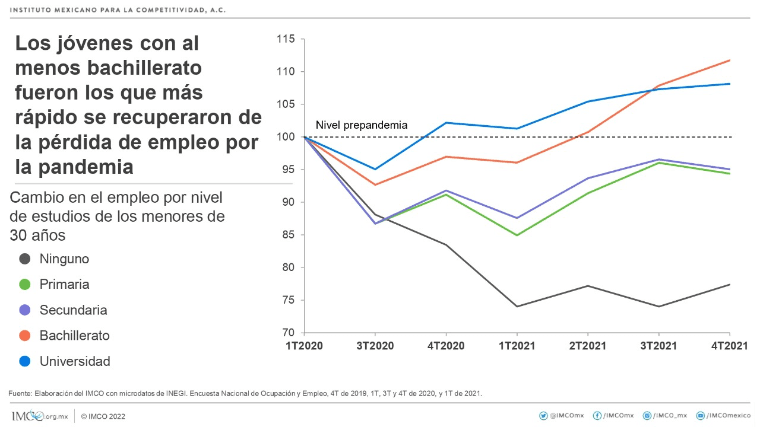Maybe the young people resist more the physical effects of covid-19, but not what it caused in labor matters. Conditions such as a high informality rate of up to 68% left them more vulnerable to layoffs. And in moments of recovery, in which we are even leaving the mask, young people with low schooling they still can’t get out of unemployment.
As of the fourth quarter of 2021, only young people “with high school and college studies they have managed to recover, and even exceed the level of employment observed before the pandemic,” says a report from the Mexican Institute for Competitiveness (Imco). Those with a baccalaureate degree increased their employment rate by almost 10% and those with university degrees, nearly 9 percent.
The report Unprepared youth are more vulnerable in the labor market highlights the progress the country has made in school enrollment and the long-term economic benefits for those who continue studying.
“In 2019, 1.4 million youth graduated from high school, a figure 1.6 times higher than a decade ago. Of those graduates, two out of three went on to pursue a bachelor’s or technical degree.” But “33% of the population of age to study a career decides not to do so and begins to work without higher education in a labor market that is increasingly demanding and complicated.”
On the eve of commemorating the International Workers’ Day it is necessary to communicate the importance and benefits of study a careercomplete higher education, “because you not only improve your working conditions, your income, you will also be able to develop greater skills and the possibility of acquiring others,” says Ana Gutiérrez, coordinator of Foreign Trade and the Labor Market at Imco, in an interview.
Two paths, two different realities
A first and compelling reason to continue studying: “Young people with a baccalaureate and a bachelor’s degree earn 14% more than those who only finish secondary school, even from the beginning of their working life”, highlights the organization.
The average monthly income of the population between 15 and 24 years old is 5,700 pesos, indicates the Imco based on information from the National Survey of Occupation and Employment (ENOE).
By levels of schooling, young people who studied only the primary they earn on average a little more than 5,100 pesos a month. If they finished the high school, his monthly salary rises to 5,420 pesos on average. With the high school they can aspire to 5,600 pesos and if they have a career they could earn almost 6,700 pesos.
“Unemployment and recovery have differed in the different generations, and among young people it also varies according to their level of education,” says economist Ana Gutiérrez. In 2020, when the pandemic hit all countries the hardest, young people with less education lost more jobs than their peers with more educational opportunities.
Due to the impact of the pandemic, young workers with primary or secondary education had a drop of almost 15% in their jobs. Meanwhile, 8% of those who have completed high school lost their source of income and 5% of those who studied a bachelor’s degree, according to the report.
And while the young people with upper secondary and higher education They have already recovered those jobs and even exceed pre-pandemic figures, the group with less schooling continues to struggle to find work: about 5% are still unemployed.
“The proportion of people from 15 to 24 years old who actively seek a job and do not find it (7.2%) is twice as high as that of the group between 25 and 44 years old (3.5%) and three times as high as that of the group between 45 and 64 years old (2.4%)” , according to the document.

Fewer studies, more informality
The path traveled by those with little schooling takes them further away from formal labor marketwhere they can enjoy social security, stability, a contract that protects them, benefits, vacations, paid disability days, etc.
“While 68% of young people between the ages of 15 and 24 are in informalitythis figure is 64% in young people with high school, and only 55% of those who have a professional career have informal employment”, the report highlights.
“The informality observed in young people of these ages is 12 percentage points higher than that observed at the national level (56%). This is worrying, since they are jobs that lack access to social security and have no guarantee of compliance with their labor rights”.
Informality is a “cross-cutting issue for the labor market, but it is especially relevant in the young population”, points out Ana Gutiérrez. Some of the public policies that governments could implement is the decoupling of social security from employment and creating incentives so that employers are willing to pay the corresponding employer contributions. Perhaps a good measure would be to reduce the costs of time and money, she adds.
Businesses could open up to professional practices, with this they bring young people closer to the world of work and help them develop different skills that they will need, he recommends. Another important element is that universities update “their educational programs, including at the regional level, so that job seekers in their society and state have the right skills.”
And “to have policies and social support infrastructure for the care of minors, adults and people with disabilities, which falls on the female populationit will also change the perception of how much women can participate in the labor market”.